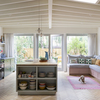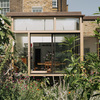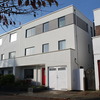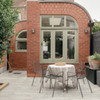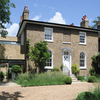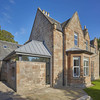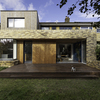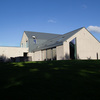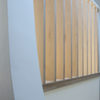Dale Road
Subscribe now to instantly view this image
Subscribe to the Architects’ Journal (AJ) for instant access to the AJ Buildings Library, an online database of nearly 2,000 exemplar buildings in photographs, plans, elevations and details.
Already a subscriber? Sign in
M7W28HI39X4QA9Q_01_House_before_the_works-MM
At the dead-end of an unassuming 1930’s street, the site benefits from a unusually generous garden.
Green-fingered Amanda and Stephen make the most of it by growing fruits and vegetables, to the point of being almost self-sufficient. They also used to enjoy the garden from their much-loved aluminium-built conservatory. But with new additions to their family, they needed more space to entertain, whilst remaining at the heart of the greenery. Extending at the side of the house was an obvious move. But what drove every design decision was the desire to retain the spirit of the old conservatory: its elegant dark slim frames, its views of the trees and hedges, and its close relationship with the surrounding grasses and flowers. Amanda and Stephen were keen on quirkiness and unusual shapes, so several card models were developed to explore options within the confines of local planning rules. The solution was to build an asymmetric double-height space: openings frame specific views out, whilst preserving privacy. Pivotal to the design is the ribbon window which places the viewer at the height of the flower bed, giving the sense that the vegetation is inside the room. A limited palette of materials was chosen to play down the visual impact of the build: Staffordshire Blue clay tiles drape over roof slopes and facades, slim black aluminium windows recede within the cladding, and grey floor tiles contrast with the bright interior. A flint plinth anchors the volume down and harks back to the self built flint garden wall that once encircled the conservatory. It is also a nod to the surrounding chalky South Downs National Park. The property was already equipped with solar panels and water butts. With the highly insulated timber framed extension, underfloor heating and productive garden, the family now has an even lighter environmental footprint.
Data
- Begun: Dec 2020
- Completed: Mar 2021
- Floor area: 30m2
- Sector: House
- Total cost: £145,000
- Funding: Private
- Tender date: Nov 2020
- Procurement: JCT Building Contract for a Home Owner/Occupier who has not appointed a consultant to oversee the work (HO/B) 2005
- Address: Lewes, BN7, United Kingdom
Professional Team 
- Architect: astula-architecture
- Client: Stephen and Amanda Burgess
- Structural engineer: Paul Ellis of Ellis Structures
- Planning consultant: Russell Pilford of Lewes District Council
- Main contractor: Danny Hepburn of St James Ecobuild
Suppliers
- Tiles: Dreadnought Tiles
- Windows & doors: Velfac
- Flat rooflights: Velux




















